Q&A – Ask Neil: August 29, 2024
(Please read these instructions carefully.)
Before you post your question, please look at recent issues to see if someone else has already asked it. You might find your answer there.
How to submit your question…
(Note: You may need to allow a pop-up window to come up in order to get the link for sending your photo(s). If you have already submitted your question and didn’t see the pop-up window, please click here.)
• Click the link provided below to post your question. After you submit your question, a new window will pop up giving you the address to which you can e-mail a SHARP, HIGH-RESOLUTION PHOTO to accompany your question. Please DO NOT SEND THUMBNAIL PHOTOS in case I need to zoom in to see things.
• Click here to post your question.
• Please ONLY POST YOUR QUESTION ONE TIME. We can only accept a set number of questions each week, and when we get duplicates it costs other people their chances.
• One question per reader, please.
• Please use this only for posting questions – not for standard emails.
• Watch for your answer in the following week’s e-gardens.
• I choose those of greatest general interest. For example, plant IDs seldom make the cut.
• I must have your first name or initials.
• I must have your city or county. (Texas is a very large state.)
QUESTION 1
WHY ARE SOME LEAVES OF MY REDPOINTE MAPLE LOOKING STRESSED?
Question: Why are some of the leaves of my Redpointe maple looking stressed? It has been getting water from the flowerbed five days per week and the other two days when I water the yard. Ron L., McKinney.
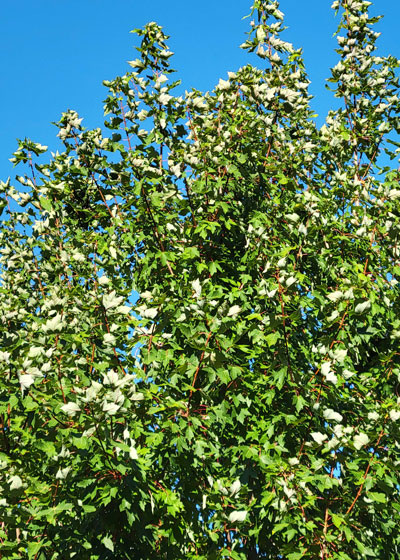
Answer: Via your note we know about the frequency of irrigation, but we do not address the quantity of water that is being applied. If you are watering flowers and turf you need to remember that both of those types of plants have shallow root systems with fibrous roots that soak up water quickly and efficiently. Trees need slower, deeper soakings. In both cases (flowers and trees) you should not have to water daily. Red maples are also native to parts of the world where daytime temperatures average 15 to 20 degrees cooler than ours do here in Texas. They’re not in love with our extended summer heat which is why you don’t see a lot of them surviving to be 25 to 30 years old in North Central Texas where you’re growing yours.
It’s also possible that your tree could have trunk damage left over from several years ago when it was planted. You didn’t include a photo of the trunk, nor did you tell me its age. Check to be sure the bark is all firmly attached. Sun scald frequently ruins young red maples after 3 to 5 years if their trunks have not been protected with paper tree wrap from the time they were planted. Meanwhile the top growth can be plugging away just fine.
Those are all things that crossed my mind as I looked at your photo.
QUESTION 2
WHAT IS CAUSING THESE SERIES OF HOLES IN MY CEDAR ELM’S TRUNK?
Question: I am very concerned about these series of holes in the trunk of one of my two cedar elms. Should I be doing something about this? Sherry G., Collin County.
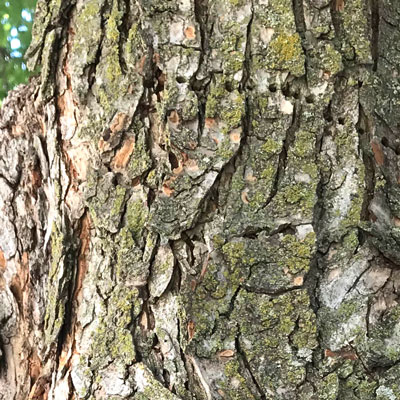
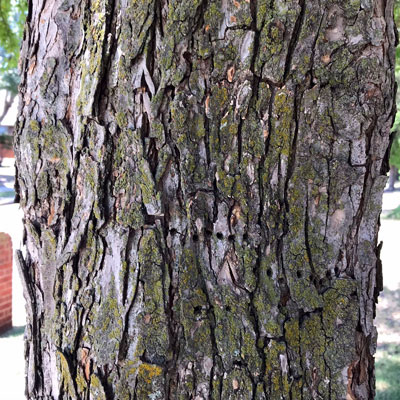
Answer: These holes are caused by the work of woodpeckers. They do not indicate presence of insects, nor do they cause any type of problem. There is absolutely no call to action. Your tree will be fine.
QUESTION 3
WHY ARE MY PEACHES SHRIVELING UP?
Question: My peach tree is healthy, but the fruit is shriveling up with a whiteish color. What am I doing wrong? Tim W., Prosper.
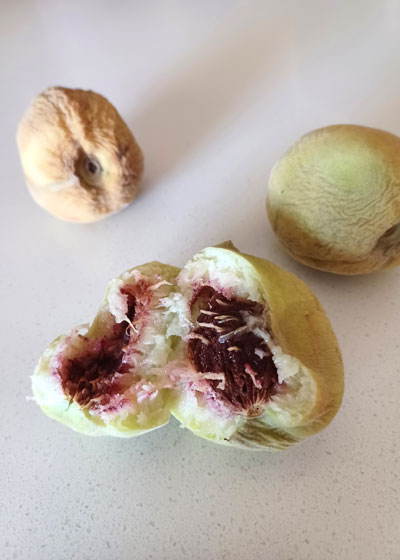
Answer: It’s very late in the season for peaches to be ripening. I am guessing that your crop has stalled out because of the very hot weather coupled with the drought. I’d put most of the blame on the drought. You need to soak fruit trees deeply weekly while they are maturing their fruit. Check the variety to see when they should be maturing. That might also give you additional clues.
QUESTION 4
WHAT IS WRONG WITH MY GULFSTREAM NANDINA?
Question: What is going wrong with my Gulfstream nandina? It gets east sun until mid-afternoon. The soil was amended and it drains well. Recently the plant has started to thin out and drop leaves. It was planted this spring, and it always seems to have adequate water. Brad S., Sanger.
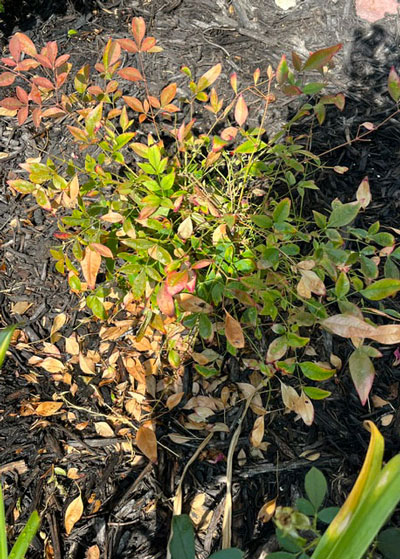
Answer: When I saw your photo, I figured your Gulfstream was 5 or 6 years old. That’s the way that variety has always done in my Blackland Prairie soil – it looks great for a few years, then it goes downhill. However, as rapidly as yours declined, it almost has to be due to a lack of water at a critical time. It only has to happen one time. It may also be against a hot, reflective wall that is too extreme for its tastes. If you end up replacing it, consider Nandina domestica ‘Compacta.’ It grows to about the same mature size, but it’s far more dependable. It has become my “nandina of choice” in our home landscape.
QUESTION 5
WHY DO I GET HUNDREDS OF ALTHAEA BUDS BUT NEVER HAVE ANY THAT OPEN?
Question: My althaea is 4 years old. It looks great, and it puts on hundreds of buds. They never open, however. There is browning at the end of each bud that makes me think a critter is chomping away, but I’ve never seen anything. Any ideas? Susan W., Overton.
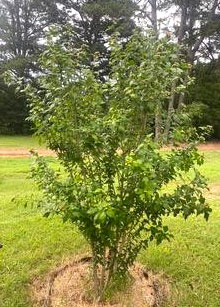
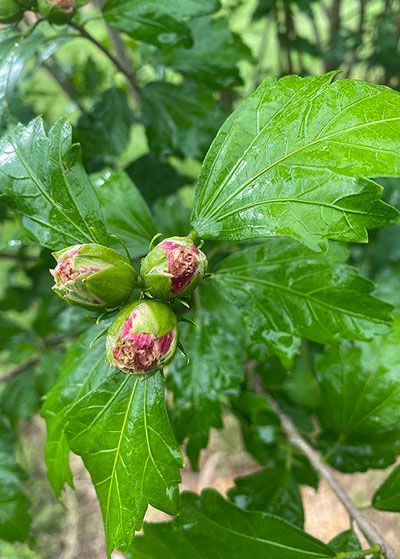
Answer: Aborting of flower buds is frustratingly common among many members of the hibiscus group. Tropical hibiscus do it notoriously. Just about the time their buds start to show color they fall to the ground. And so it is with roses-of-Sharon (althaeas). You’ll notice it happens anytime there is a dramatic change in temperature or humidity. We have cool, moist spring weather. The plants thrive. Then they’re hit by 100F days and parching drought and suddenly their buds start to fall. We lose as many as half or two-thirds of the crop. It’s unusual to lose as many as you have.
I looked closely at your photo, and I don’t see evidence of anything having eaten into the buds. I just think the plant got too dry at a vulnerable time. Next time around keep it moist and mulched and see if it doesn’t perform better.
QUESTION 6
I NEED GUIDANCE ON A WATERING SCHEDULE.
Question: Denton has just reduced the number of days we are allowed to water. It’s now once a week, before 10 a.m. and after 6 p.m. I have bermuda. Should I water in the evenings or in the mornings? Or both? Extended station times? Jerry F., Denton.
Answer: You can do just fine with that. Early morning watering is always best (between 4 and 8 a.m.). That reduces the chance of diseases. You don’t want your grass staying wet all night, notably if you have St. Augustine. Water deeply and the grass will get along just fine. We’re almost through the summer, so good times are right around the corner. Leave your mower set at the recommended height for your type of bermuda.
QUESTION 7
WHY IS PART OF THIS SHRUB DEAD?
Question: What kind of shrub is this and why is part of it dead? It’s on the northeast side of the house. I have similar shrubs near it, and they are doing well. David Y., Rowlett.
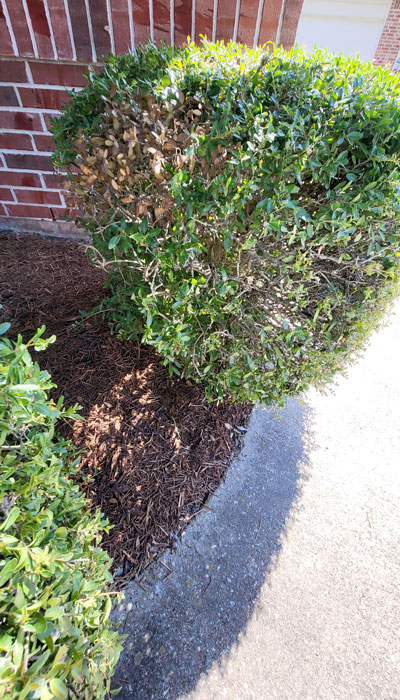
Answer: This is a yaupon holly. Zoom in on the leaves and you’ll see the rounded scallops. It’s an outstanding type of shrub, but you’re pruning it to excess. Because of the repeated pruning the plant is running out of vigor. I’ve never seen it develop any type of insect or disease that would kill it. It may have gotten too dry, but I suspect the extreme pruning is mostly to blame.
